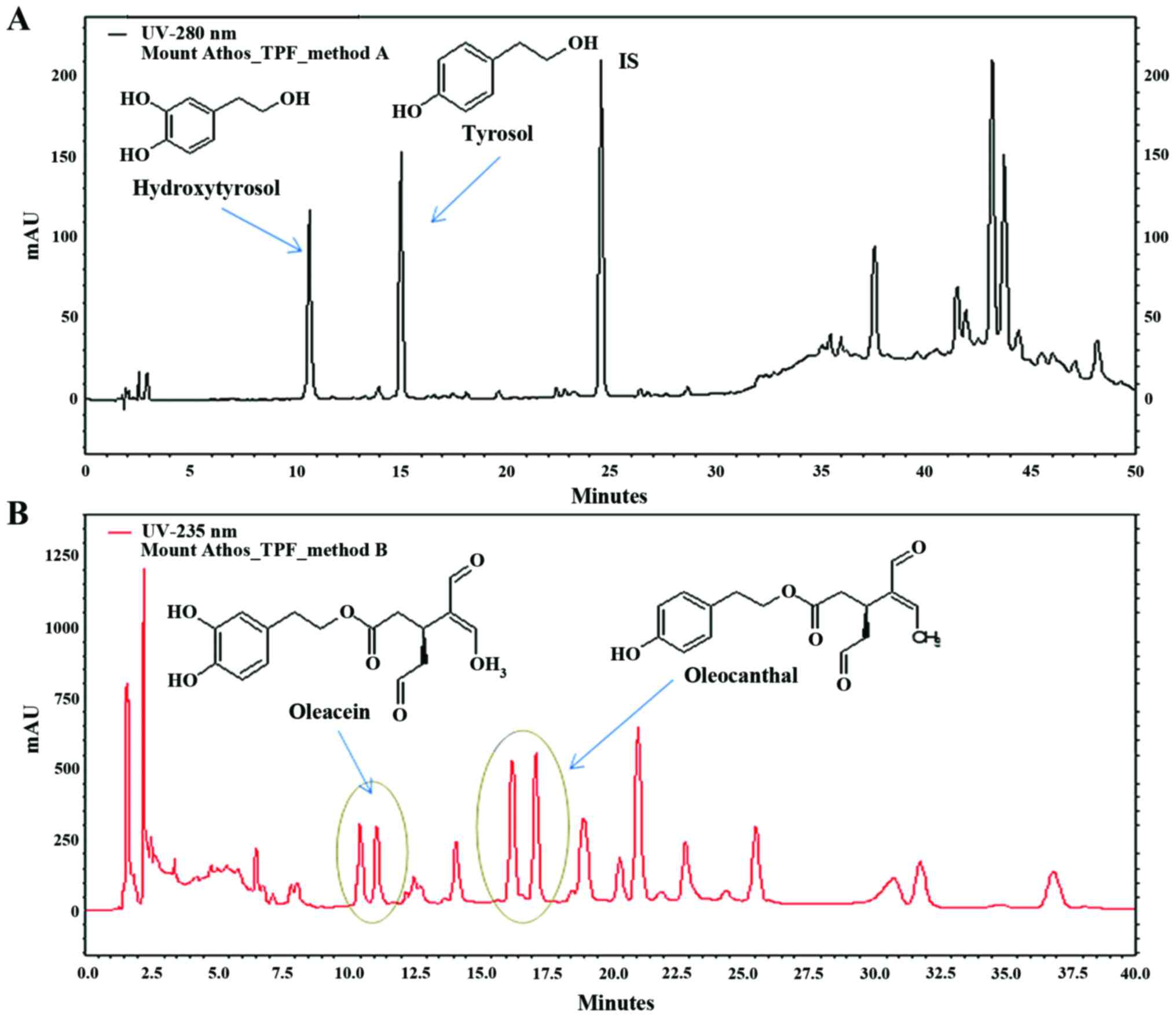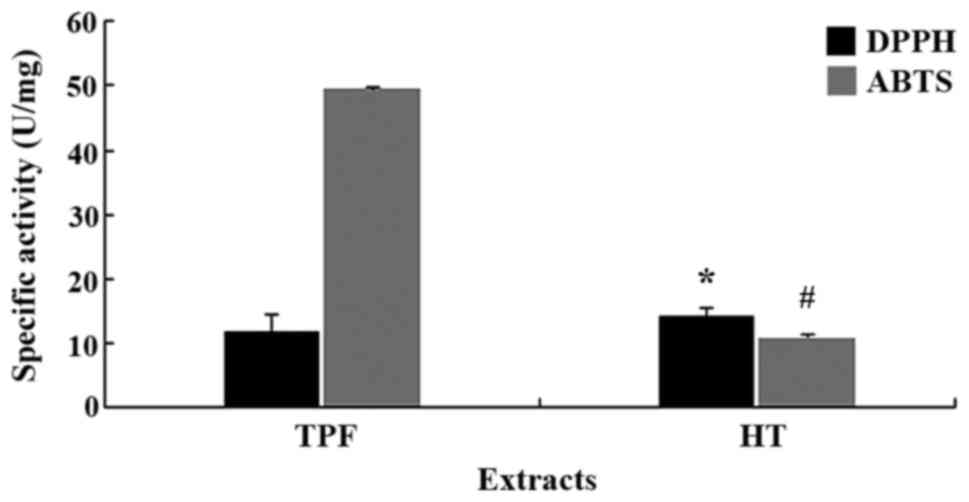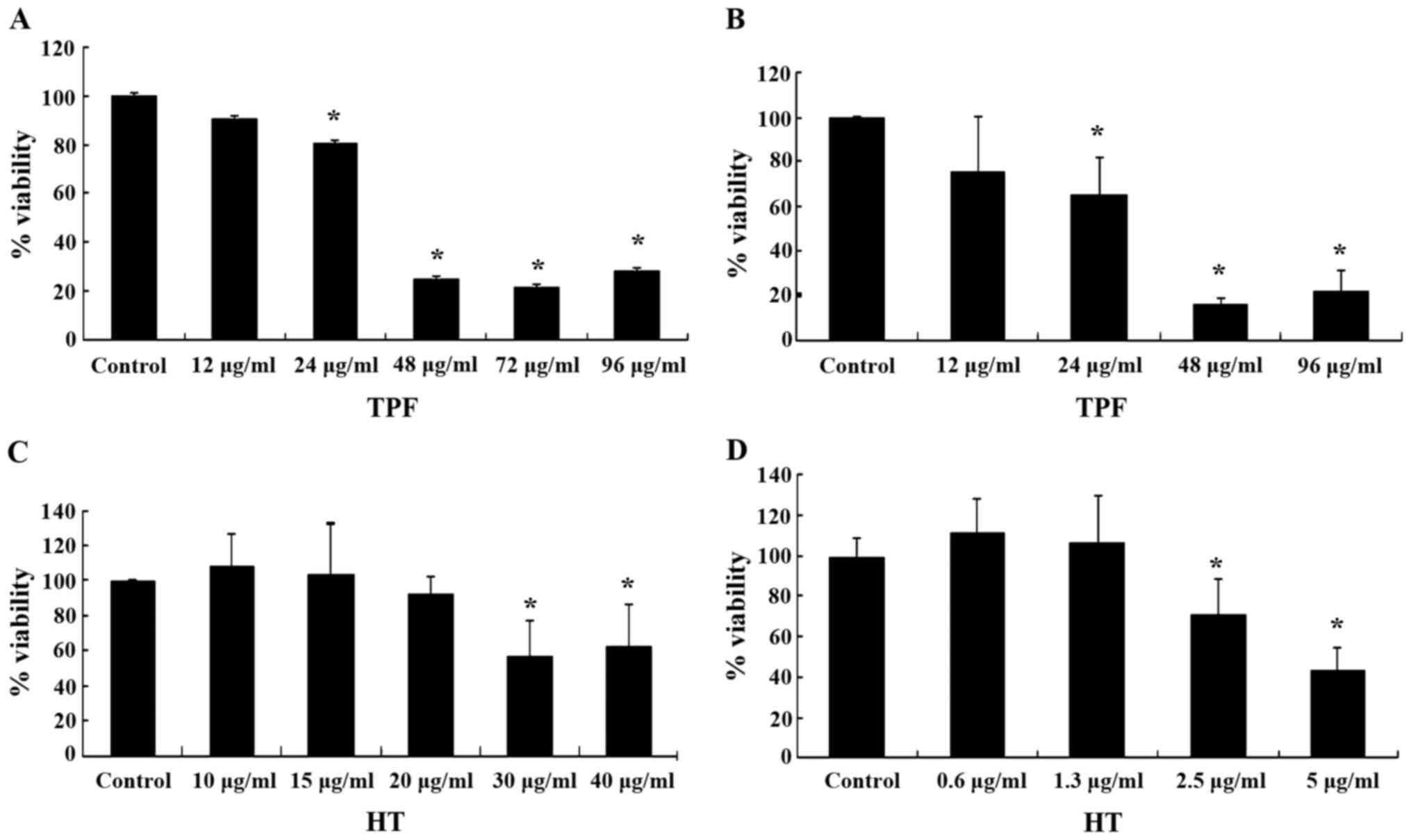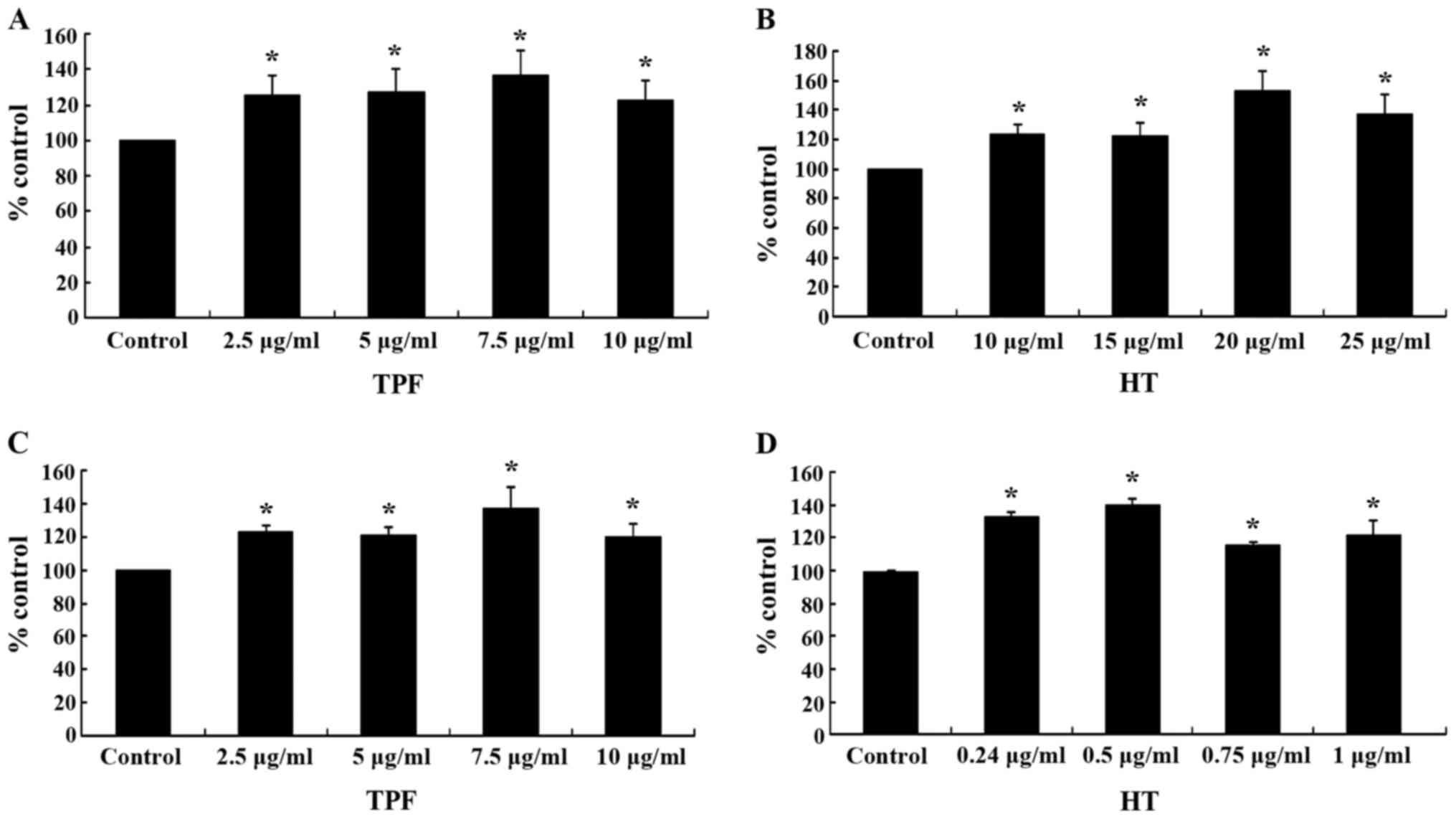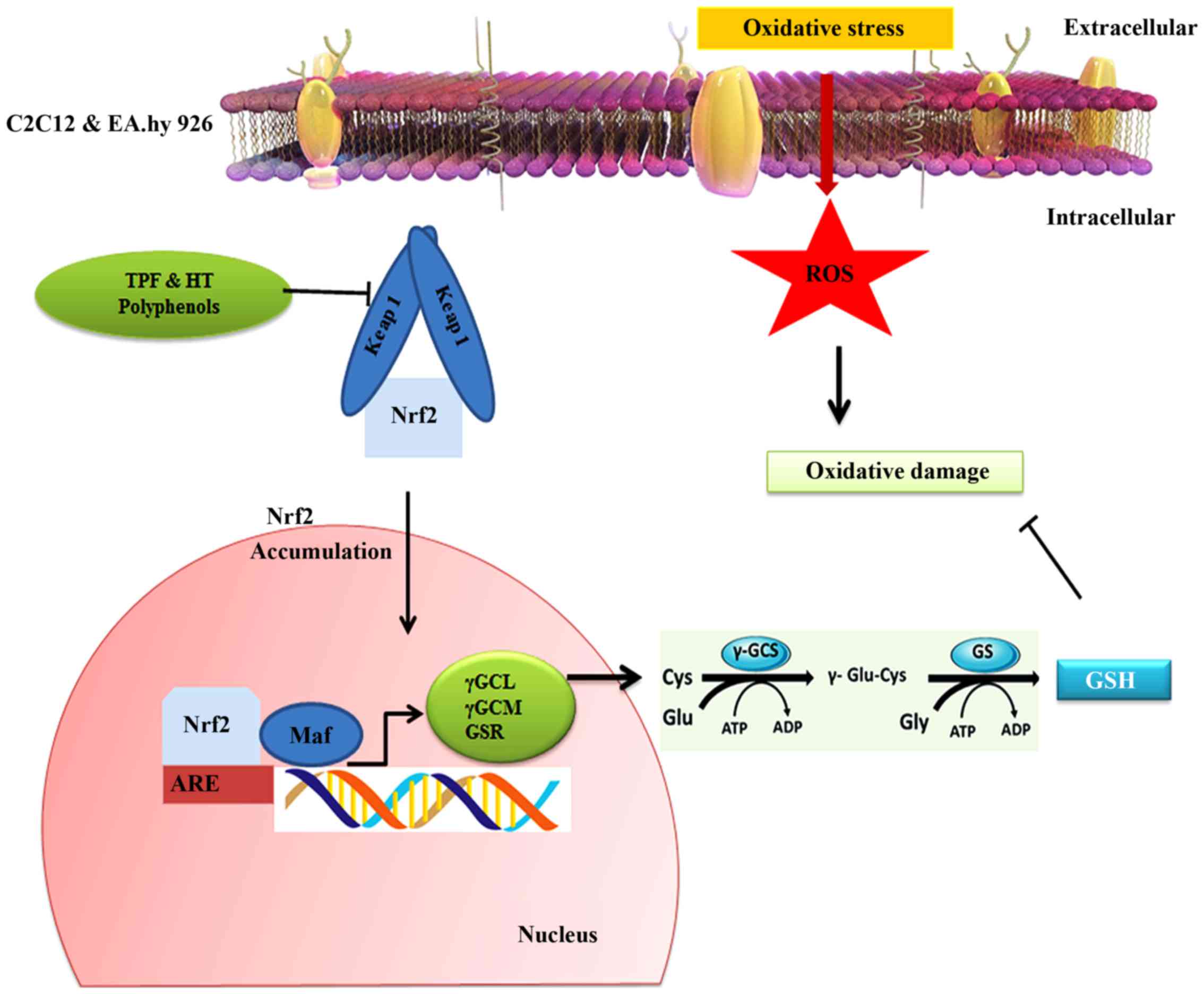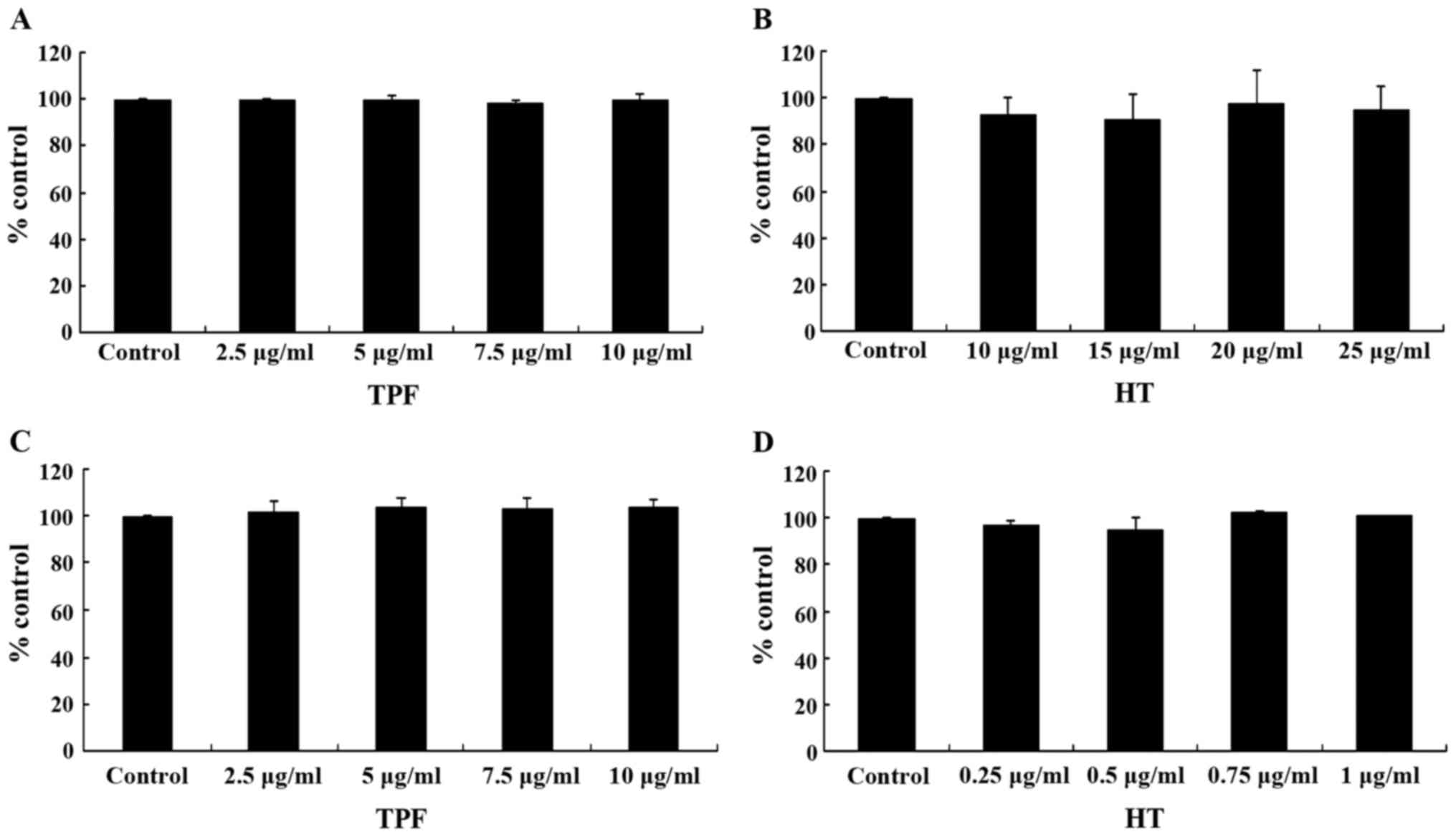|
1
|
Schieber M and Chandel NS: ROS function in
redox signaling and oxidative stress. Curr Biol. 24:R453–R462.
2014. View Article : Google Scholar : PubMed/NCBI
|
|
2
|
Pham-Huy LA, He H and Pham-Huy C: Free
radicals, antioxidants in disease and health. Int J Biomed Sci.
4:89–96. 2008.PubMed/NCBI
|
|
3
|
Landete JM: Dietary intake of natural
antioxidants: Vitamins and polyphenols. Crit Rev Food Sci Nutr.
53:706–721. 2013. View Article : Google Scholar : PubMed/NCBI
|
|
4
|
Fang YZ, Yang S and Wu G: Free radicals,
antioxidants, and nutrition. Nutrition. 18:872–879. 2002.
View Article : Google Scholar : PubMed/NCBI
|
|
5
|
Landete JM: Updated knowledge about
polyphenols: functions, bioavailability, metabolism, and health.
Crit Rev Food Sci Nutr. 52:936–948. 2012. View Article : Google Scholar : PubMed/NCBI
|
|
6
|
Li HY, Yang M, Li Z and Meng Z: Curcumin
inhibits angio-tensin II-induced inflammation and proliferation of
rat vascular smooth muscle cells by elevating PPAR-γ activity and
reducing oxidative stress. Int J Mol Med. 39:1307–1316.
2017.PubMed/NCBI
|
|
7
|
Kerasioti E, Stagos D, Georgatzi V, Bregou
E, Priftis A, Kafantaris I and Kouretas D: Antioxidant effects of
sheep whey protein on endothelial cells. Oxid Med Cell Longev.
2016:65857372016. View Article : Google Scholar : PubMed/NCBI
|
|
8
|
Deanfield JE, Halcox JP and Rabelink TJ:
Endothelial function and dysfunction: Testing and clinical
relevance. Circulation. 115:1285–1295. 2007.PubMed/NCBI
|
|
9
|
Woywodt A, Bahlmann FH, De Groot K, Haller
H and Haubitz M: Circulating endothelial cells: Life, death,
detachment and repair of the endothelial cell layer. Nephrol Dial
Transplant. 17:1728–1730. 2002. View Article : Google Scholar : PubMed/NCBI
|
|
10
|
Kokura S, Wolf RE, Yoshikawa T, Granger DN
and Aw TY: Molecular mechanisms of neutrophil-endothelial cell
adhesion induced by redox imbalance. Circ Res. 84:516–524. 1999.
View Article : Google Scholar : PubMed/NCBI
|
|
11
|
Zou Y, Yoon S, Jung KJ, Kim CH, Son TG,
Kim MS, Kim YJ, Lee J, Yu BP and Chung HY: Upregulation of aortic
adhesion molecules during aging. J Gerontol A Biol Sci Med Sci.
61:232–244. 2006. View Article : Google Scholar : PubMed/NCBI
|
|
12
|
Spanou C, Veskoukis AS, Kerasioti T,
Kontou M, Angelis A, Aligiannis N, Skaltsounis AL and Kouretas D:
Flavonoid glycosides isolated from unique legume plant extracts as
novel inhibitors of xanthine oxidase. PLoS One. 7:e322142012.
View Article : Google Scholar : PubMed/NCBI
|
|
13
|
Goutzourelas N, Stagos D, Spanidis Y,
Liosi M, Apostolou A, Priftis A, Haroutounian S, Spandidos DA,
Tsatsakis AM and Kouretas D: Polyphenolic composition of grape stem
extracts affects antioxidant activity in endothelial and muscle
cells. Mol Med Rep. 12:5846–5856. 2015.PubMed/NCBI
|
|
14
|
Reid MB: Free radicals and muscle fatigue:
Of ROS, canaries, and the IOC. Free Radic Biol Med. 44:169–179.
2008. View Article : Google Scholar : PubMed/NCBI
|
|
15
|
Rafehi H, Smith AJ, Balcerczyk A, Ziemann
M, Ooi J, Loveridge SJ, Baker EK, El-Osta A and Karagiannis TC:
Investigation into the biological properties of the olive
poly-phenol, hydroxytyrosol: Mechanistic insights by genome-wide
mRNA-Seq analysis. Genes Nutr. 7:343–355. 2012. View Article : Google Scholar
|
|
16
|
Montaño A, Hernández M, Garrido I, Llerena
JL and Espinosa F: Fatty acid and phenolic compound concentrations
in eight different monovarietal virgin olive oils from extremadura
and the relationship with oxidative stability. Int J Mol Sci.
17:172016. View Article : Google Scholar
|
|
17
|
Local Food-Nutraceuticals Consortium:
Understanding local Mediterranean diets: a multidisciplinary
pharmacological and ethnobotanical approach. Pharmacol Res.
52:353–366. 2005. View Article : Google Scholar : PubMed/NCBI
|
|
18
|
Trichopoulou A, Costacou T, Bamia C and
Trichopoulos D: Adherence to a Mediterranean diet and survival in a
Greek population. N Engl J Med. 348:2599–2608. 2003. View Article : Google Scholar : PubMed/NCBI
|
|
19
|
Trichopoulou A, Lagiou P, Kuper H and
Trichopoulos D: Cancer and Mediterranean dietary traditions. Cancer
Epidemiol Biomarkers Prev. 9:869–873. 2000.PubMed/NCBI
|
|
20
|
Brinkman MT, Buntinx F, Kellen E, Van
Dongen MC, Dagnelie PC, Muls E and Zeegers MP: Consumption of
animal products, olive oil and dietary fat and results from the
Belgian case-control study on bladder cancer risk. Eur J Cancer.
47:436–442. 2011. View Article : Google Scholar
|
|
21
|
Oliveras-Ferraros C, Fernández-Arroyo S,
Vazquez-Martin A, Lozano-Sánchez J, Cufí S, Joven J, Micol V,
Fernández-Gutiérrez A, Segura-Carretero A and Menendez JA: Crude
phenolic extracts from extra virgin olive oil circumvent de novo
breast cancer resistance to HER1/HER2-targeting drugs by inducing
GADD45-sensed cellular stress, G2/M arrest and hyperacetylation of
Histone H3. Int J Oncol. 38:1533–1547. 2011.PubMed/NCBI
|
|
22
|
Tunca B, Tezcan G, Cecener G, Egeli U, Ak
S, Malyer H, Tumen G and Bilir A: Olea europaea leaf extract alters
microRNA expression in human glioblastoma cells. J Cancer Res Clin
Oncol. 138:1831–1844. 2012. View Article : Google Scholar : PubMed/NCBI
|
|
23
|
Bouallagui Z, Han J, Isoda H and Sayadi S:
Hydroxytyrosol rich extract from olive leaves modulates cell cycle
progression in MCF-7 human breast cancer cells. Food Chem Toxicol.
49:179–184. 2011. View Article : Google Scholar
|
|
24
|
Cárdeno A, Sánchez-Hidalgo M,
Cortes-Delgado A and Alarcón de la Lastra C: Mechanisms involved in
the antiproliferative and proapoptotic effects of unsaponifiable
fraction of extra virgin olive oil on HT-29 cancer cells. Nutr
Cancer. 65:908–918. 2013. View Article : Google Scholar : PubMed/NCBI
|
|
25
|
Acquaviva R, Di Giacomo C, Sorrenti V,
Galvano F, Santangelo R, Cardile V, Gangia S, D'Orazio N, Abraham
NG and Vanella L: Antiproliferative effect of oleuropein in
prostate cell lines. Int J Oncol. 41:31–38. 2012.PubMed/NCBI
|
|
26
|
Coccia A, Bastianelli D, Mosca L,
Monticolo R, Panuccio I, Carbone A, Calogero A and Lendaro E: Extra
virgin olive oil phenols suppress migration and invasion of T24
human bladder cancer cells through modulation of matrix
metalloproteinase-2. Nutr Cancer. 66:946–954. 2014. View Article : Google Scholar : PubMed/NCBI
|
|
27
|
Coccia A, Mosca L, Puca R, Mangino G,
Rossi A and Lendaro E: Extra-virgin olive oil phenols block cell
cycle progression and modulate chemotherapeutic toxicity in bladder
cancer cells. Oncol Rep. 36:3095–3104. 2016.PubMed/NCBI
|
|
28
|
Miró-Casas E, Covas MI, Fitó M,
Farré-Albadalejo M, Marrugat J and de la Torre R: Tyrosol and
hydroxytyrosol are absorbed from moderate and sustained doses of
virgin olive oil in humans. Eur J Clin Nutr. 57:186–190. 2003.
View Article : Google Scholar : PubMed/NCBI
|
|
29
|
Keys A, Menotti A, Karvonen MJ, Aravanis
C, Blackburn H, Buzina R, Djordjevic BS, Dontas AS, Fidanza F, Keys
MH, et al: The diet and 15-year death rate in the seven countries
study. Am J Epidemiol. 124:903–915. 1986. View Article : Google Scholar : PubMed/NCBI
|
|
30
|
Obied HK, Prenzler PD, Omar SH, Ismael R,
Servili M, Esposto S, Taticchi A, Selvaggini R and Urbani S:
Pharmacology of Olive Biophenols. Advances in Molecular Toxicology.
Fishbein JC and Heilman JM: 6. Elsevier; Amsterdam: pp. 195–242.
2012, View Article : Google Scholar
|
|
31
|
Lewandowska U, Szewczyk K, Hrabec E,
Janecka A and Gorlach S: Overview of metabolism and bioavailability
enhancement of polyphenols. J Agric Food Chem. 61:12183–12199.
2013. View Article : Google Scholar : PubMed/NCBI
|
|
32
|
Schaffer S, Podstawa M, Visioli F, Bogani
P, Müller WE and Eckert GP: Hydroxytyrosol-rich olive mill
wastewater extract protects brain cells in vitro and ex vivo. J
Agric Food Chem. 55:5043–5049. 2007. View Article : Google Scholar : PubMed/NCBI
|
|
33
|
Rietjens SJ, Bast A and Haenen GR: New
insights into controversies on the antioxidant potential of the
olive oil antioxidant hydroxytyrosol. J Agric Food Chem.
55:7609–7614. 2007. View Article : Google Scholar : PubMed/NCBI
|
|
34
|
Rodríguez-Morató J, Boronat A, Kotronoulas
A, Pujadas M, Pastor A, Olesti E, Pérez-Mañá C, Khymenets O, Fitó
M, Farré M, et al: Metabolic disposition and biological
significance of simple phenols of dietary origin: Hydroxytyrosol
and tyrosol. Drug Metab Rev. 48:218–236. 2016. View Article : Google Scholar : PubMed/NCBI
|
|
35
|
Angelis A, Hamzaoui M, Aligiannis N, Nikou
T, Michailidis D, Gerolimatos P, Termentzi A, Hubert J, Halabalaki
M, Renault JH, et al: An integrated process for the recovery of
high added-value compounds from olive oil using solid support free
liquid-liquid extraction and chromatography techniques. J
Chromatogr A. 1491:126–136. 2017. View Article : Google Scholar : PubMed/NCBI
|
|
36
|
Mastralexi A, Nenadis N and Tsimidou MZ:
Addressing analytical requirements to support health claims on
'olive oil polyphenols' (EC Regulation 432/2012). J Agric Food
Chem. 62:2459–2461. 2014. View Article : Google Scholar : PubMed/NCBI
|
|
37
|
Impellizzeri J and Lin J: A simple
high-performance liquid chromatography method for the determination
of throat-burning oleocanthal with probated antiinflammatory
activity in extra virgin olive oils. J Agric Food Chem.
54:3204–3208. 2006. View Article : Google Scholar : PubMed/NCBI
|
|
38
|
Vougogiannopoulou K, Lemus C, Halabalaki
M, Pergola C, Werz O, Smith AB III, Michel S, Skaltsounis L and
Deguin B: One-step semisynthesis of oleacein and the determination
as a 5-lipoxygenase inhibitor. J Nat Prod. 77:441–445. 2014.
View Article : Google Scholar : PubMed/NCBI
|
|
39
|
Singleton VL, Orthofer R and
Lamuela-Raventos RM: Analysis of total phenols and other oxidation
substrates and antioxidants by means of Folin-Ciocalteu reagent.
Methods Enzymol. 299:152–178. 1998. View Article : Google Scholar
|
|
40
|
Brand-Williams W, Cuvelier ME and Berset
C: Use of a free radical method to evaluate antioxidant activity.
Lebensm Wiss Technol. 28:25–30. 1995. View Article : Google Scholar
|
|
41
|
Cano A, Hernandez-Ruiz J, García-Cánovas
F, Acosta M and Arnao MB: An end-point method for estimation of the
total antioxidant activity in plant material. Phytochem Anal.
9:196–202. 1998. View Article : Google Scholar
|
|
42
|
Goutzourelas N, Stagos D, Demertzis N,
Mavridou P, Karterolioti H, Georgadakis S, Kerasioti E, Aligiannis
N, Skaltsounis L, Statiri A, et al: Effects of polyphenolic grape
extract on the oxidative status of muscle and endothelial cells.
Hum Exp Toxicol. 33:1099–1112. 2014. View Article : Google Scholar : PubMed/NCBI
|
|
43
|
Priftis A, Stagos D, Konstantinopoulos K,
Tsitsimpikou C, Spandidos DA, Tsatsakis AM, Tzatzarakis MN and
Kouretas D: Comparison of antioxidant activity between green and
roasted coffee beans using molecular methods. Mol Med Rep.
12:7293–7302. 2015.PubMed/NCBI
|
|
44
|
Vulcano I, Halabalaki M, Skaltsounis L and
Ganzera M: Quantitative analysis of pungent and anti-inflammatory
phenolic compounds in olive oil by capillary electrophoresis. Food
Chem. 169:381–386. 2015. View Article : Google Scholar
|
|
45
|
Keiler AM, Zierau O, Bernhardt R,
Scharnweber D, Lemonakis N, Termetzi A, Skaltsounis L, Vollmer G
and Halabalaki M: Impact of a functionalized olive oil extract on
the uterus and the bone in a model of postmenopausal osteoporosis.
Eur J Nutr. 53:1073–1081. 2014. View Article : Google Scholar
|
|
46
|
Angelis A, Hubert J, Aligiannis N,
Michalea R, Abedini A, Nuzillard JM, Gangloff SC, Skaltsounis AL
and Renault JH: Bio-guided isolation of methanol-soluble
metabolites of common spruce (Picea abies) bark by-products and
investigation of their dermo-cosmetic properties. Molecules.
21:212016. View Article : Google Scholar
|
|
47
|
Agiomyrgianaki A, Petrakis PV and Dais P:
Influence of harvest year, cultivar and geographical origin on
Greek extra virgin olive oils composition: A study by NMR
spectroscopy and biometric analysis. Food Chem. 135:2561–2568.
2012. View Article : Google Scholar : PubMed/NCBI
|
|
48
|
Pliszka B, Huszcza-Ciołkowska G and
Wierzbicka E: Effects of solvents and extraction methods on the
content and antiradical activity of polyphenols from fruits
Actinidia arguta, Crataegus monogyna, Gaultheria procumbens and
Schisandra chinensis. Acta Sci Pol Technol Aliment. 15:57–63. 2016.
View Article : Google Scholar
|
|
49
|
Schlesier K, Harwat M, Böhm V and Bitsch
R: Assessment of antioxidant activity by using different in vitro
methods. Free Radic Res. 36:177–187. 2002. View Article : Google Scholar : PubMed/NCBI
|
|
50
|
Zou X, Feng Z, Li Y, Wang Y, Wertz K,
Weber P, Fu Y and Liu J: Stimulation of GSH synthesis to prevent
oxidative stress-induced apoptosis by hydroxytyrosol in human
retinal pigment epithelial cells: Activation of Nrf2 and
JNK-62/SQSTM1 pathways. J Nutr Biochem. 23:994–1006. 2012.
View Article : Google Scholar
|
|
51
|
Moi P, Chan K, Asunis I, Cao A and Kan YW:
Isolation of NF-E2-related factor 2 (Nrf2), a NF-E2-like basic
leucine zipper transcriptional activator that binds to the tandem
NF-E2/AP1 repeat of the beta-globin locus control region. Proc Natl
Acad Sci USA. 91:9926–9930. 1994. View Article : Google Scholar : PubMed/NCBI
|
|
52
|
Li W and Kong AN: Molecular mechanisms of
Nrf2-mediated antioxidant response. Mol Carcinog. 48:91–104. 2009.
View Article : Google Scholar :
|
|
53
|
Nguyen T, Nioi P and Pickett CB: The
Nrf2-antioxidant response element signaling pathway and its
activation by oxidative stress. J Biol Chem. 284:13291–13295. 2009.
View Article : Google Scholar : PubMed/NCBI
|
|
54
|
Kobayashi M and Yamamoto M: Nrf2-Keap1
regulation of cellular defense mechanisms against electrophiles and
reactive oxygen species. Adv Enzyme Regul. 46:113–140. 2006.
View Article : Google Scholar : PubMed/NCBI
|
|
55
|
Manzanares MA, Solanas M, Moral R, Escrich
R, Vela E, Costa I and Escrich E: Dietary extra-virgin olive oil
and corn oil differentially modulate the mRNA expression of
xeno-biotic-metabolizing enzymes in the liver and in the mammary
gland in a rat chemically induced breast cancer model. Eur J Cancer
Prev. 24:215–222. 2015. View Article : Google Scholar
|
|
56
|
Visioli F, Wolfram R, Richard D, Abdullah
MI and Crea R: Olive phenolics increase glutathione levels in
healthy volunteers. J Agric Food Chem. 57:1793–1796. 2009.
View Article : Google Scholar : PubMed/NCBI
|
|
57
|
Covas MI, Nyyssönen K, Poulsen HE,
Kaikkonen J, Zunft HJ, Kiesewetter H, Gaddi A, de la Torre R, Mursu
J, Bäumler H, et al EUROLIVE Study Group: The effect of polyphenols
in olive oil on heart disease risk factors: A randomized trial. Ann
Intern Med. 145:333–341. 2006. View Article : Google Scholar : PubMed/NCBI
|
|
58
|
Procházková D, Boušová I and Wilhelmová N:
Antioxidant and prooxidant properties of flavonoids. Fitoterapia.
82:513–523. 2011. View Article : Google Scholar : PubMed/NCBI
|
|
59
|
Lambert JD and Elias RJ: The antioxidant
and pro-oxidant activities of green tea polyphenols: A role in
cancer prevention. Arch Biochem Biophys. 501:65–72. 2010.
View Article : Google Scholar : PubMed/NCBI
|
|
60
|
Fukumoto LR and Mazza G: Assessing
antioxidant and prooxidant activities of phenolic compounds. J
Agric Food Chem. 48:3597–3604. 2000. View Article : Google Scholar : PubMed/NCBI
|
|
61
|
Sakihama Y, Cohen MF, Grace SC and
Yamasaki H: Plant phenolic antioxidant and prooxidant activities:
Phenolics-induced oxidative damage mediated by metals in plants.
Toxicology. 177:67–80. 2002. View Article : Google Scholar : PubMed/NCBI
|
|
62
|
Maurya DK and Devasagayam TP: Antioxidant
and prooxidant nature of hydroxycinnamic acid derivatives ferulic
and caffeic acids. Food Chem Toxicol. 48:3369–3373. 2010.
View Article : Google Scholar : PubMed/NCBI
|
|
63
|
Aquilano K, Baldelli S and Ciriolo MR:
Glutathione: New roles in redox signaling for an old antioxidant.
Front Pharmacol. 5:1962014. View Article : Google Scholar : PubMed/NCBI
|
|
64
|
Kerasioti E, Stagos D, Priftis A,
Aivazidis S, Tsatsakis AM, Hayes AW and Kouretas D: Antioxidant
effects of whey protein on muscle C2C12 cells. Food Chem.
155:271–278. 2014. View Article : Google Scholar : PubMed/NCBI
|



